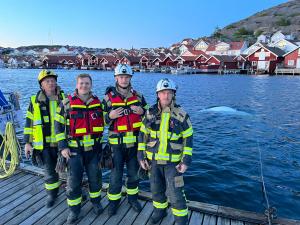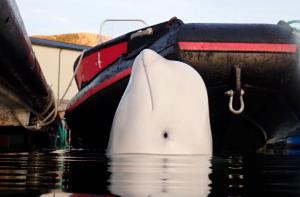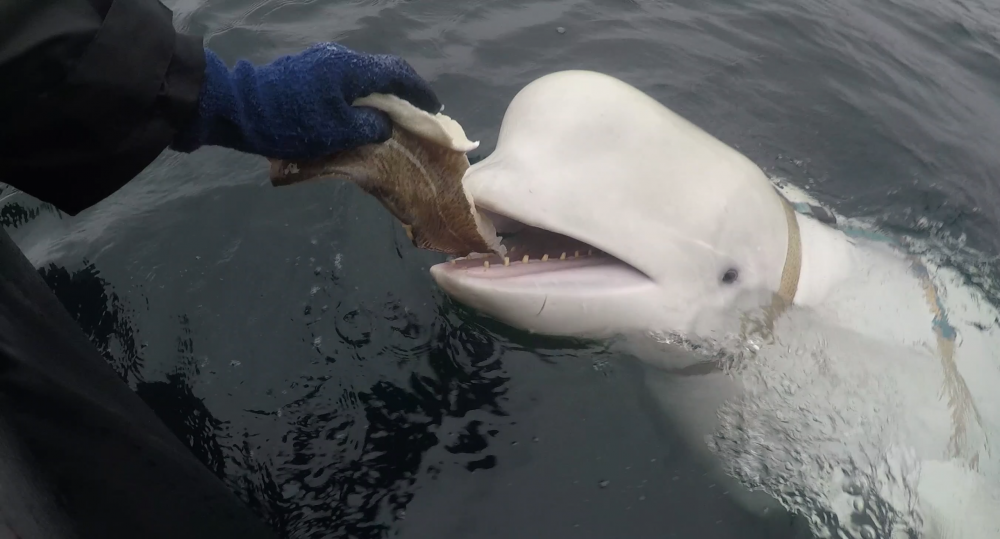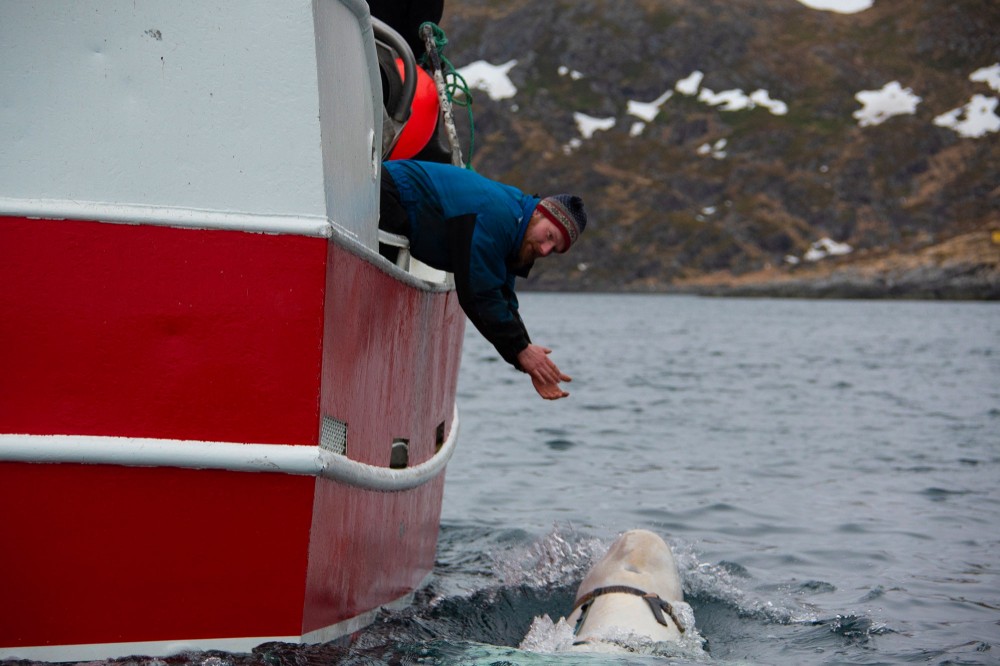Russian 'spy' whale surfaces in Sweden
Stockholm (AFP) – A harness-wearing Beluga whale that turned up in Norway in 2019, sparking speculation it was a spy trained by the Russian navy, has appeared off Sweden's coast, an organisation following him said Monday.
Issued on: 29/05/2023
Stockholm (AFP) – A harness-wearing Beluga whale that turned up in Norway in 2019, sparking speculation it was a spy trained by the Russian navy, has appeared off Sweden's coast, an organisation following him said Monday.
Issued on: 29/05/2023
A 2019 image from the Norwegian Directorate of Fisheries (Sea Surveillance Service) shows a white whale now observed off Sweden's southwestern coast wearing a harness © Jorgen REE WIIG / NTB Scanpix/AFP/File
First discovered in Norway's far northern region of Finnmark, the whale spent more than three years slowly moving down the top half of the Norwegian coastline, before suddenly speeding up in recent months to cover the second half and on to Sweden.
On Sunday, he was observed in Hunnebostrand, off Sweden's southwestern coast.
"We don't know why he has sped up so fast right now," especially since he is moving "very quickly away from his natural environment", Sebastian Strand, a marine biologist with the OneWhale organisation, told AFP.
"It could be hormones driving him to find a mate. Or it could be loneliness as Belugas are a very social species -- it could be that he's searching for other Beluga whales."
Believed to be 13-14 years old, Strand said the whale is "at an age where his hormones are very high".
The closest population of Belugas is however located in the Svalbard archipelago, in Norway's far north.
The whale is not believed to have seen a single Beluga since arriving in Norway in April 2019.
Norwegians nicknamed it "Hvaldimir" -- a pun on the word "whale" in Norwegian, hval, and a nod to its alleged association to Russia.
When he first appeared in Norway's Arctic, marine biologists from the Norwegian Directorate of Fisheries removed an attached man-made harness.
The harness had a mount suited for an action camera and the words "Equipment St. Petersburg" printed on the plastic clasps.
Directorate officials said Hvaldimir may have escaped an enclosure, and may have been trained by the Russian navy as it appeared to be accustomed to humans.
Moscow never issued any official reaction to Norwegian speculation he could be a "Russian spy".
The Barents Sea is a strategic geopolitical area where Western and Russian submarine movements are monitored.
It is also the gateway to the Northern Route that shortens maritime journeys between the Atlantic and Pacific oceans.
Strand said the whale's health "seemed to be very good" in recent years, foraging wild fish under Norway's salmon farms.
But his organisation was concerned about Hvaldimir's ability to find food in Sweden, and already observed some weight loss.
Beluga whales, which can reach a size of six metres (20 feet) and live to between 40 and 60 years of age, generally inhabit the icy waters around Greenland, northern Norway and Russia.
© 2023 AFP
First discovered in Norway's far northern region of Finnmark, the whale spent more than three years slowly moving down the top half of the Norwegian coastline, before suddenly speeding up in recent months to cover the second half and on to Sweden.
On Sunday, he was observed in Hunnebostrand, off Sweden's southwestern coast.
"We don't know why he has sped up so fast right now," especially since he is moving "very quickly away from his natural environment", Sebastian Strand, a marine biologist with the OneWhale organisation, told AFP.
"It could be hormones driving him to find a mate. Or it could be loneliness as Belugas are a very social species -- it could be that he's searching for other Beluga whales."
Believed to be 13-14 years old, Strand said the whale is "at an age where his hormones are very high".
The closest population of Belugas is however located in the Svalbard archipelago, in Norway's far north.
The whale is not believed to have seen a single Beluga since arriving in Norway in April 2019.
Norwegians nicknamed it "Hvaldimir" -- a pun on the word "whale" in Norwegian, hval, and a nod to its alleged association to Russia.
When he first appeared in Norway's Arctic, marine biologists from the Norwegian Directorate of Fisheries removed an attached man-made harness.
The harness had a mount suited for an action camera and the words "Equipment St. Petersburg" printed on the plastic clasps.
Directorate officials said Hvaldimir may have escaped an enclosure, and may have been trained by the Russian navy as it appeared to be accustomed to humans.
Moscow never issued any official reaction to Norwegian speculation he could be a "Russian spy".
The Barents Sea is a strategic geopolitical area where Western and Russian submarine movements are monitored.
It is also the gateway to the Northern Route that shortens maritime journeys between the Atlantic and Pacific oceans.
Strand said the whale's health "seemed to be very good" in recent years, foraging wild fish under Norway's salmon farms.
But his organisation was concerned about Hvaldimir's ability to find food in Sweden, and already observed some weight loss.
Beluga whales, which can reach a size of six metres (20 feet) and live to between 40 and 60 years of age, generally inhabit the icy waters around Greenland, northern Norway and Russia.
© 2023 AFP
NEWS PROVIDED BY
OneWhale
May 29, 2023,

Hvaldimir when he first arrived in Norway wearing a harness

Hvaldimir with Swedish firefighters who immediately came to help
'Russian spy' beluga whale Hvaldimir has now left Norwegian waters for Sweden.
We are impressed by Sweden’s show of care for Hvaldimir. They immediately contacted us upon his arrival, and even closed a bridge to protect him.”
— Regina Haug
KUNGSHAMN, SWEDEN, May 28, 2023/EINPresswire.com/ -- After four years of swimming south down the coast of Norway, Hvaldimir – known worldwide as the ‘Russian spy’ beluga whale – is now in Swedish waters.
The nonprofit organization OneWhale has been working to protect Hvaldimir and advocating for his safety since 2019. Their “Team Hvaldimir” is on site and working side-by-side with the Swedish authorities. Founder Regina Haug says, “We are impressed by Sweden’s show of care for Hvaldimir. They immediately contacted us upon his arrival, and even closed a bridge to protect him.”
Hvaldimir made global news in the past several days when he appeared in Oslo, the capitol city of Norway. Being in an area of one million people with heavy boat traffic and major industry had the OneWhale team extremely concerned for his safety. But the famous beluga skirted around the dangerous waters of Oslo for Sweden.
OneWhale President Rich German says, “Hvaldimir’s situation remains an extremely vulnerable one as Sweden is a highly populated country, but we are very grateful Swedish authorities have quickly taken action to care for the whale.”
Plans are underway to move the whale far north to arctic waters. OneWhale has partnered with the town of Hammerfest and together they are creating the Norwegian Whale Reserve. When finished, the massive 500-acre marine reserve would be a safe place for Hvaldimir to live until an attempt can be made to release him back into a wild beluga population. The reserve will also be a home for other whales who are currently living in captivity.
Hvaldimir first arrived in Hammerfest, Norway in April 2019 wearing a harness that read ‘Equipment St. Petersburg.’ It is believed he was part of a Russian marine mammal military program for several years. He is a friendly, tamed, displaced, formerly captive whale who relies on humans for social interaction. Belugas are highly social whales and he has been living all alone the past four years.
Communication between OneWhale and the Swedish authorities are ongoing as Hvaldimir’s perilous situation continues.
The "spy whale” is back
The well known ‘Whaledimir’ beluga whale has been detected in the waters near Oslo.
Former Russian Spy Whale Faces His Greatest Danger
NEWS PROVIDED BY
OneWhale
May 24, 2023

Here's Hvaldimir next to a boat at a salmon farm

Hvaldimir in a very unnatural setting in Oslo
‘Russian spy’ whale lost in Oslo, Norway – city of over one million people. Massive crowds and boat traffic create the ‘perfect storm’ for tragedy to occur.
With swift action Hvaldimir could transition from being a symbol of inhumane animal treatment to a great ambassador of compassion between humans and marine life, but only if we’re able to act quickly.”
— Rich German
OSLO, NORWAY, May 24, 2023/EINPresswire.com/ -- Hvaldimir, known worldwide as the ‘Russian spy’ beluga whale, is now lost in the industrial ports of the capitol city of Oslo – which has a population of over one million people. Massive crowds eager to see the whale, heavy boat traffic and warming weather are creating the ‘perfect storm’ for tragedy to occur.
Hvaldimir first arrived in Hammerfest, Norway in April 2019 wearing a harness that read ‘Equipment St. Petersburg.’ It is believed he was part of a Russian marine mammal military program for several years. He is a friendly, tamed, displaced, formerly captive whale who has been living all alone since his arrival in the country. Hvaldimir seeks out humans for his social needs and due to that behavior has been severely injured multiple times by boat propellers and foreign objects.
To help protect him, the nonprofit organization OneWhale created a public safety program and has been on-site with Hvaldimir since the summer of 2021. OneWhale Founder Regina Crosby Haug recalls, “Because of his incredible charm, his viral fame grew quickly which multiplied the public’s interest to see him in person. Totally understandable, however there were no guardrails around him, just hundreds of people and lots of boats - a risky situation for both the humans and the whale. We put on yellow vests, enlisted volunteers and showed up. This is what Team Hvaldimir still does every day.”
The initiative has been successful in creating safety practices and education around Hvaldimir, however, it cannot prevent the potential disaster he is now facing. According to OneWhale President Rich German, “Without proper intervention it is only a matter of time before Hvaldimir gets seriously injured again or killed. He did not choose to be in this predicament. Hvaldimir needs and deserves help.”
In a measure to provide short term protection, OneWhale is formulating an emergency transport plan to move Hvaldimir far north to arctic waters. OneWhale is in contact with the Norwegian authorities whose permission is required to intervene on behalf of the whale.
“We are very hopeful the authorities will agree to move Norway’s beloved beluga to safety. Norwegians have fallen in love with Hvaldimir and have compassion for his incredible story,” says Haug.
In an effort to provide protection and rehabilitation for Hvaldimir, OneWhale has partnered with the town of Hammerfest and together they are creating the Norwegian Whale Reserve. When finished, the massive 500-acre marine reserve would be a safe place for Hvaldimir to live until an attempt can be made to release him back into a wild beluga population. The reserve will also be a home for other whales who will be released from captivity.
There are presently over 300 belugas and 56 orcas confined in concrete tanks around the world. As laws and attitudes change in favor of whales having freedom, many of these animals will need an ocean home and the Norwegian Whale Reserve can be a solution for many of them. According to German, “With swift action Hvaldimir could transition from being a symbol of inhumane animal treatment to a great ambassador of compassion between humans and marine life, but only if we’re able to act quickly.”
Discussions between OneWhale and the authorities in Oslo continue.
Rich German
OneWhale
rich@onewhale.org



No comments:
Post a Comment